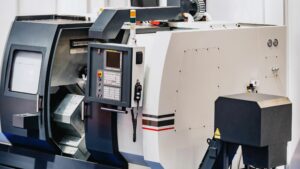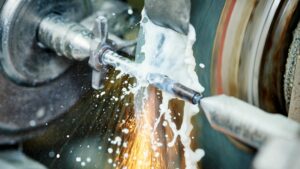Cold cutting, a term that might seem an oxymoron to the uninitiated, refers to a collection of cutting processes that operate without the generation of heat or, more specifically, without a heat-affected zone (HAZ). This innovative method has revolutionized industrial cutting by providing an answer to the challenges posed by traditional torch cutting techniques which include distortion, oxidation, and other heat-related issues.
What is the Cold Cutting Process?
The cold cutting process process employs tools and machinery designed to cut materials using techniques that maintain the integrity of the workpiece by avoiding thermal stress. By understanding cold cutting’s distinct approach, industries can harness its full potential for intricate and demanding applications.
The cold cutting method, exemplified by technologies such as water jet cutting and diamond wire saws, operates under a principle that eschews heat to minimize the impact on material properties.
This technique ensures that the heat affected zone (HAZ) is eliminated, preserving the original characteristics of the metal or pipe being worked on.
Precision is paramount in cold cutting, where tools like clamshell cutters, frame cutters, and cold cutting saws make precise incisions. These devices are engineered to avoid the creation of sparks or the risk of igniting hydrocarbons, which is especially critical in environments like petrochemical plants or oil and gas pipelines.
The pipe cold cutting machine, a quintessential example, operates with remarkable accuracy across various pipe diameters, often implemented in decommissioning projects or when retrofitting existing piping systems.
Why is Cold Cutting Preferred?
Advantages of Cold Cutting
Cold cutting comes with a host of advantages that make it the go-to option for many industrial applications. These benefits stem from its fundamental characteristic—its ability to cut without inducing heat stress on the material.
- Speed: The cold cutting process is generally faster than traditional methods because it eliminates the need for a cooling period. Machines like band saws and clamshell lathes can execute cuts rapidly, translating to shorter job completion times and increased production rates.
- Accuracy: With cold cutting, there is a higher level of accuracy due to the absence of heat that can warp or distort the material being cut. Precision tools such as clamshell cutters and diamond wire saws ensure that each cut is consistent with the last, achieving the repeatability required for stringent quality control.
- Cost-effectiveness: Over time, cold cutting can prove to be more economical as it reduces material waste and increases efficiency. Fewer materials need to be scrapped due to errors, and the tools themselves, such as saw blades and machine tools, often have a longer life due to less exposure to extreme temperatures.
- Versatility: This method is versatile enough to be used on a wide range of materials without compromising quality. Whether it’s a cold cutting saw cutting through metal blades or an abrasive water jet slicing through composite materials, the adaptability of cold cutting technologies is unmatched.
- Safety: Cold cutting is a preferred choice in potentially volatile environments due to its non-sparking nature. This safety feature is vital in fields like oil, gas, and chemical industries, where the absence of a flame or high heat reduces the risk of fire and explosion.
What are the Different Types of Cold Cutting Machines?
The cold cutting industry offers an array of machines, each tailored to suit specific needs and materials. These machines, from pipe cold cutting devices to frame cutters, provide tailored solutions that enhance cutting processes.
The realm of cold cutting teems with a spectrum of machines, each serving a unique role within different industries. These devices stand at the vanguard of innovation in material fabrication, operating without the introduction of heat, thus preserving material integrity and ensuring safety, especially within volatile environments where sparks are a major risk.
Below we delve deeper into the types of cold cutting machinery that have revolutionized the way industries approach the cutting process.
Pipe Cold Cutting Machines
Pipe cold cutting machines are indispensable in scenarios where the integrity of the pipe’s material properties must be maintained, avoiding the heat affected zone (HAZ) that torch cutting would introduce.
Employing these machines signifies a commitment to precision, as they’re engineered to manage pipe diameters meticulously. Applications extend across various sectors, from oil and gas pipelines to water and wastewater product lines.
- Clamshell cutters, for instance, have revolutionized on-site pipe modification tasks. This machining system’s design allows for a secure embrace around pipes, facilitating beveling, facing, and cutting operations. The precision of a clamshell lathe cutter extends to its ability to create complex geometries, like saddle cuts, on the pipe surface.
- Frame cutters, often included in the cold cutting machine tools category, excel in cutting pipe frameworks where traditional saws fall short. Their robust construction enables them to manage the rigors of heavy-duty materials and the demands of continuous production environments.
Diamond Wire Saws
Diamond wire saws have emerged as a symbol of cutting-edge precision, with their diamond-encrusted wires cutting through hardened materials as if they were butter. These saws are remarkably versatile, adapting to varying diameters and material densities, thus accommodating a broader range of cutting tasks.
- The efficiency of diamond wire saws can be measured by the fineness of the cut and the absence of a HAZ, making them the tool of choice for materials where thermal distortion must be avoided.
- In applications ranging from decommissioning in the petrochemical industry to precise cuts required in stone and concrete fabrication, diamond wire saws offer a method that combines efficacy with a high-quality finish.
Clamshell Pipe Cutter
The clamshell pipe cutter, with its unique design reminiscent of its namesake, is an exemplar of specialized pipe cutting tools. It offers a swift and precise method to execute round cuts on pipes, often in situations where other machines would be impractical due to their size or the heat they generate.
- The clamshell cutter’s versatility extends to tasks such as preparing pipe ends for welding, ensuring a clean and accurate bevel, and it is invaluable in field repair work where precision and efficiency are paramount.
- The clamshell cutter operates by encasing the pipe, much like a clamshell, and rotating around it with a cutting blade that slices through the metal, providing a smooth cross-section without warping the pipe due to excessive heat.
Band Saws and Diamond Wire Saws
Band saws and diamond wire saws represent two distinct paths within the realm of cold cutting, each with their pros and cons depending on the application.
- Band saws are lauded for their straightforward operation and consistency, often used in manufacturing settings for cutting metal rods, tubes, and profiles. With varied blade tooth profiles and speeds, they accommodate different materials and hardness, while maintaining a clean cut.
- Diamond wire saws, on the other hand, offer unparalleled precision. The diamond particles embedded in the wire saw blades provide a cutting edge that remains sharp longer than traditional metal blades, making them suitable for materials that are tough, brittle, or require a high-quality finish.
Abrasive Water Jet Cutting
Abrasive water jet cutting is a technique that combines the erosion effect of water with the grinding action of abrasive particles. This cold cutting method is esteemed for its versatility and precision, capable of cutting through a diverse range of materials and thicknesses without compromising material structure due to heat.
The Techniwaterjet Intec™G2 CNC Waterjet Series is a testament to the capabilities of abrasive water jet cutting machines. These machines are engineered with an eye toward reliability and long-term use, featuring minimal moving parts and resistance to corrosion, making them a formidable asset in the cutting process.
This cutting technology has a wide array of applications, from creating intricate patterns on tiles and stones to slicing through thick plates of steel or composite materials. Its ability to cut without heat ensures the integrity of the material is maintained, which is crucial in industries where material performance cannot be compromised.
Cold Cutting Procedure Steps
A detailed understanding of the cold cutting procedure is crucial for optimal results. From the initial setup to the final cut, each step is designed to ensure precision and quality.
- The procedure typically commences with a thorough inspection of the material and cutting equipment.
- The cutting path is then determined and programmed into the machine if required.
- Once everything is set, the cold cutting process begins, following the predetermined path to the completion of the cut.
What are the Applications of Cold Cutting in Industries?
Cold cutting finds its applications in various industries, each leveraging its precision and efficiency to enhance production and maintain material integrity. In the petrochemical and oil industries, cold cutting is essential not only for cutting pipelines and storage tanks to prevent the risk of ignition but also for decommissioning obsolete structures.
It is a preferred method where hot work permits are hard to obtain due to the presence of hydrocarbons which could pose a risk of explosion.
Within the construction sector, cold cutting goes beyond rebar, beams, and structural elements; it’s also applied in creating precise openings in walls for windows and doors, where the integrity of the surrounding material must remain uncompromised. In these environments, the absence of heat ensures the strength of materials like concrete and steel is not affected, preserving the structural integrity of the build.
- Maritime Applications: Cold cutting technology, particularly water jet cutting, plays a critical role in shipbuilding and repair. It’s employed in cutting metal plates for hulls, intricate components for engines, and in decommissioning tasks where precision cuts are necessary to separate materials without causing damage to adjoining sections.
- Manufacturing of Heavy Machinery: Manufacturers of heavy machinery utilize cold cutting for the production of large, robust components. Diamond wire saws, clamshell cutters, and band saws are integral in cutting through large diameters of metal, ensuring components like gears and engine blocks are produced to exact specifications.
- Aerospace and Defense: In industries where precision is non-negotiable, such as aerospace, cold cutting methods like waterjet cutting and abrasive water streams are used to shape components made from advanced materials, including titanium and Inconel. The process is valued for its ability to produce components with exact tolerances, essential for aerospace engineering.
How to Choose the Right Cold Cutting Machine?
Selecting the right cold cutting machine involves considering several factors to ensure compatibility with the intended cutting tasks. The size and capability of the machine should match the size and type of materials you need to cut. It is imperative to choose a machine that can handle the required pipe diameters without compromising the precision or quality of the cut.
When examining the types of cuts needed, one must consider the variety offered by different machines—whether you need straight cuts, beveled edges, or complex patterns. The cutting process can be varied using devices such as frame cutters for larger cross-sections, clamshell cutters for precision, and band saws for straight cuts.
Budgeting is not only about the initial purchase price; it involves looking at the total cost of ownership. This includes maintenance, operating costs, and potential downtime that could affect production. Machines with higher automation may cost more initially but could save money in the long term through improved efficiency and lower labor costs.
- Machine Tooling and Accessories: Evaluate the range of tooling and accessories that are compatible with the machine. From saw blades to diamond wires, the availability and cost of replacements will affect long-term operations.
- Material Properties: The materials you intend to cut dictate the type of cold cutting machine required. Harder metals like steel may necessitate a machine with diamond wire saws, while softer materials could be handled by less intensive cutting tools.
- Operational Environment: Consider the environment in which the machine will operate. If the location is prone to dust or hazardous chemicals, a cutting machine that can withstand such conditions while preventing contamination is vital.
- Safety Features: The cutting machine should have built-in safety features that protect the operators as well as the material being cut. Safety measures are particularly important when working with high-pressure systems like water jet cutting or when cutting in explosive environments.
This consideration of varied factors ensures that the selected cold cutting machine not only fulfills the needs of the present job but also aligns with future projects and applications within the industry.
With advancements in technology, machines that offer precision and reduced heat affected zones are increasingly favored for their efficiency and the quality of their cut, paving the way for innovative applications across all sectors that rely on metal fabrication and precision cutting.
How Much Does Cold Cutting Cost?
In exploring the cost associated with cold cutting, we navigate through the financial landscape of acquiring and operating such precision-based machinery. The types of cold cutting machines are as varied as their applications, from clamshell cutters designed for pipe modification to abrasive water jet systems renowned for their versatility across materials.
- Clamshell Cutters: Operational costs range between $100-$150 per hour.
- Abrasive Water Jet Systems: Typically $85-$200 per hour, depending on the pressure and material. However, keep in mind that it can get much higher or lower, depending on the scenario.
- Diamond Wire Saws: Can vary widely, generally costing around $120-$180 per hour.
- Cold Cutting Saws: Operating expenses are approximately $70-$130 per hour.
Each type offers a unique balance between precision and efficiency, a calculation that must consider the per-hour operational cost, inclusive of aspects such as blade wear, energy consumption, and maintenance.
How Much Does a Cold Cutting Machine Cost?
The financial commitment to owning a cold cutting machine is not a fixed figure but rather a spectrum influenced by a myriad of factors like machine capabilities, technology employed, and manufacturer reputation.
- Clamshell Lathes: Prices range from $5,000 to $50,000.
- Diamond Wire Saws: These can cost between $10,000 and $60,000.
- Abrasive Water Jet Machines: Range from $40,000 to over $100,000, up to a million for the largest models.
- Cold Cutting Band Saws: These machines can be found for $1,500 to $10,000.
What are Important Safety Measures in Cold Cutting?
The cutting process, regardless of the method, presents various risks, making safety a paramount concern. In the realm of cold cutting, where pipe cold cutting machines and clamshell cutters operate, the absence of sparks and flame does not negate the need for vigilance.
- Personal Protective Equipment (PPE): PPE is crucial for operators of cold cutting machines. This includes, but is not limited to, safety goggles to shield eyes from metal shavings, gloves to protect hands from sharp edges, and ear protection against the noise of cutting operations. The selection of PPE should be task-specific, accounting for the potential hazards identified in a risk assessment.
- Rigorous Training: Comprehensive training for operators is not just about handling the machinery but also about understanding the intricacies of the cold cutting process. This encompasses recognizing the characteristics of different metals and the correct application of cold cutting methods. A well-trained operator will be adept in both setup and operation, which includes aligning the cutting tool properly and adjusting feed rates to ensure clean cuts.
- Regular Maintenance Checks: The integrity of cold cutting machines hinges on their operational condition. Regular checks and maintenance help prevent mechanical failures that could pose safety risks or compromise the quality of cuts. Maintenance activities should include checking the condition of cutting blades, ensuring that the clamshell lathe or frame cutters are free from defects, and verifying that all safety guards are in place and functional.
- Environment Monitoring: Monitoring the cutting environment is essential, especially when working in locations where the presence of hydrocarbons or other flammable substances can pose a risk of fire or explosion. Effective monitoring involves using gas detectors to ensure that there are no leaks and maintaining adequate ventilation to prevent the accumulation of potentially explosive gases.
Design and Preparation Tips for Effective Cold Cutting
The prelude to effective cold cutting involves not just the machine setup but also the meticulous design and preparation of the workpiece. The following considerations can significantly affect the outcome:
- Analyzing Material Properties: Understanding how different materials respond to cold cutting.
- Preparing the Work Area: Ensuring it’s free from contaminants that could interfere with the cutting.
- Designing for Support: Accounting for holes, slots, and unsupported areas that might affect integrity during cutting.
- Measuring for Precision: Accurate measurements to align with required tolerances and specifications.
Every factor, from the size of the pipe diameters to the design of the unsupported sections, impacts the cold cutting process, necessitating a detailed preparation protocol.
Conclusion
Concluding the discourse on cold cutting, we reaffirm its significance in the modern fabrication and maintenance landscape. Its benefits—ranging from the precision of the cuts to the preservation of material integrity—underscore its essential role in a multitude of applications.





